
The Heteropola gyrostaura are represented by some possible sigmoid organisms : If we discriminate between the 'box' and the 'lid' of the diatomean shell in general, then Gyrosigma, which was treated of earlier, namely as a representative of the homopola sigmostaura (i.e. a sigmoid form with homopolar main axis) will be considered as to belong to the present promorphological group (heteropola gyrostaura).
The basic form of the heteropola gyrostaura is represented by a heteropolar regular or amphitect pyramid of which the cross axes show a sigmoid form. This implies that the pyramid, which we will call a g y r o i d p y r a m i d, does not possess mirror planes parallel to the main axis. The latter nevertheless is a 2- or more-fold rotation axis, which means that the symmetry of the pyramid is such that when it is rotated about its main axis by a certain angle it will be mapped onto itself, i.e. the resulting figure remains the same after such a rotation. There is not a single mirror plane present. The only symmetry possessed by these forms is rotational symmetry (rotation axes). Those that are derived from regular pyramids can have their main axis as a 2-fold, 3-fold, 4-fold, 5-fold, 6-fold, etc. rotation axis. we will call them Gyrostaura homogyrostaura. Those that are derived from amphitect pyramids on the other hand, have as their only symmetry element a 2-fold rotation axis.

As already indicated, the Heteropola gyrostaura divide into two subgroups which are analogues of the Heteropola homostaura and the Heteropola heterostaura, i.e. respectively depending on a regular pyramid and on an amphitect pyramid. The next Figures exemplify them with basic forms possessing four antimers.
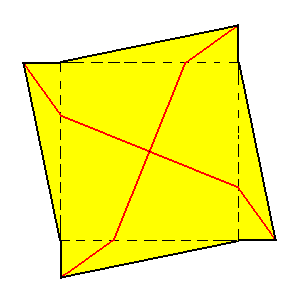
Figure 2. Base of a regular gyroid pyramid with four antimers. The 4-fold rotation axis (main axis) is perpendicular to the plane of the drawing and goes through the center of the image. The two s i g m o i d radial cross axes are shown in red. Their shape, as drawn, only symbolizes their sigmoid character.
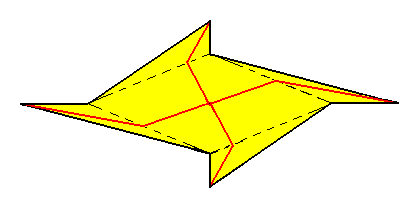
Figure 3. Base of an amphitect gyroid pyramid with four antimers. The 2-fold rotation axis (main axis) is perpendicular to the plane of the drawing and goes through the center of the image. The two s i g m o i d radial non-equivalent cross axes are shown in red. There shape as drawn only symbolize their sigmoid character.
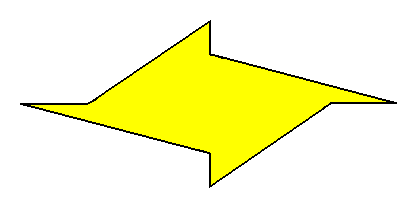
Figure 4. Base of an amphitect gyroid pyramid with four antimers. Auxiliary lines and cross axes omitted. The 2-fold rotation axis (main axis) is perpendicular to the plane of the drawing and goes through the center of the image.
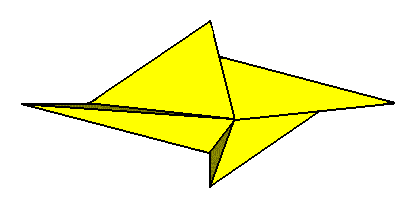
As will be now clear, the Heteropola gyrostaura can be divided into two subgroups. When based on a regular pyramid (Figure 2) we will call them Gyrostaura homogyrostaura. When based on an amphitect pyramid (Figure 3, 4 and 5) we will call them Gyrostaura heterogyrostaura.
Twisted regular pyramidal bodies with a heteropolar main axis.
The basic forms belonging to this group can be derived from regular pyramids, by eliminating all mirror planes parallel to the main axis. The main axis remains a rotational axis.
The symmetry of the Homogyrostaura tetramera (See Figure above) can crystallographically be described as 4, meaning that the only symmetry element present is a 4-fold rotation axis, and is the same as that of crystals of the Pyramidal Class (4) of the Tetragonal Crystal System (See the Special Series on the first Part of this website, accessible via back to homepage).
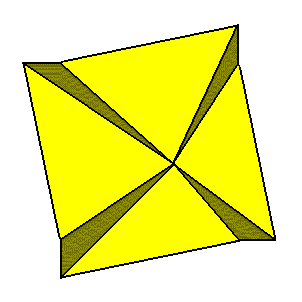
The symmetry of the Homogyrostaura trimera can crystallographically be described as 3, meaning that the only symmetry element present is a 3-fold rotation axis, and is the same as that of crystals of the Trigonal-pyramidal Class (3) of the Hexagonal Crystal System. The geometric body representing this symmetry is the 3-fold Gyroid Pyramid. See next Figure.
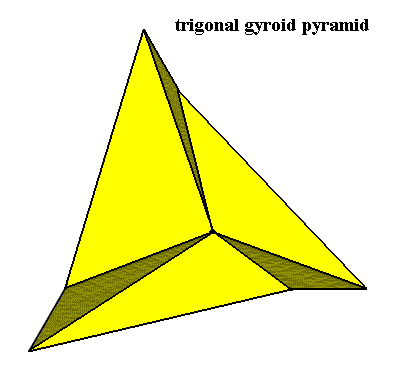
Figure 7. Slightly oblique top view of a Trigonal ( 3-fold ) Gyroid Pyramid. The only symmetry element present is a 3-fold rotation axis. There are no mirror planes.
The Homogyrostaura pentamera are regular 5-fold gyroid pyramids. They are potentially realized in Organisms, but cannot be realized in Crystals.
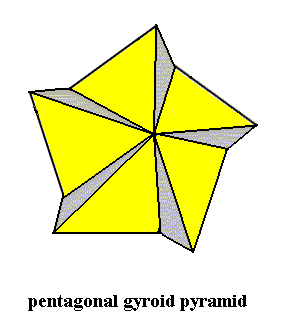
Figure 7a. Slightly oblique top view of a Pentagonal ( 5-fold ) Gyroid Pyramid. The only symmetry element present is a 5-fold rotation axis. There are no mirror planes.
The symmetry of the Homogyrostaura hexamera can crystallographically be described as 6, meaning that the only symmetry element present is a 6-fold rotation axis, and is the same as that of crystals of the Hexagonal-pyramidal Class (6) of the Hexagonal Crystal System. See next Figures.
In the next Figure we indicate, by means of the base of the pyramid, how to construct a six-fold gyroid pyramid, as the basic form of the Homogyrostaura hexamera (Stauraxonia heteropola gyrostaura).
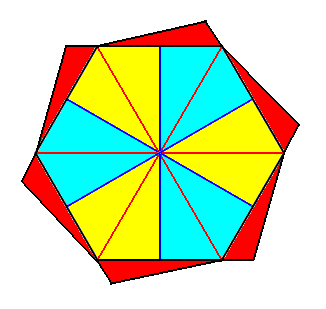
Figure 8. Construction of a regular six-fold gyroid pyramid by means of adaptation of the base of a regular six-fold pyramid. Attachment of the red parts, as indicated in the Figure, causes the elimination of the mirror lines inherent in a regular hexagon. For the pyramid this means the disappearance of all vertical mirror planes, i.e. mirror planes containing the main axis. The 6-fold rotation axis, though, remains.
The next Figure depicts the pyramid, finally resulting from this construction.
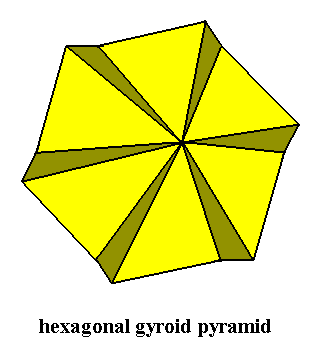
Twisted amphitect pyramidal bodies with a heteropolar main axis.
These basic forms can be derived from amphitect pyramids by eliminating all mirror planes parallel to the main axis. This main axis is (still) a 2-fold rotation axis.
The next Figure depicts a member of the Heterogyrostaura with four antimers (it belongs to the Heterogyrostaura tetramera).

The symmetry of the Heterogyrostaura can, crystallographically be described as 2, meaning that the only symmetry element present is a 2-fold rotation axis, and is the same as that of crystals belonging to the Sphenoidic Class (2) of the Monoclinic Crystal System (See the Special Series on the first Part of this website, accessible via back to homepage).
The next Figures depict yet another species of the Heterogyrostaura, namely one that belongs to the Heterogyrostaura dimera. It can be derived from an amphitect four-fold gyroid pyramid. It possesses two antimers.
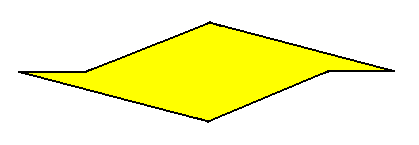
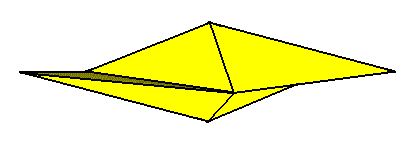
The stereometric basic form of the Heterogyrostaura dimera is materialized in the diatomean Gyrosigma, if we discriminate between the bottom part and the top part (lid) of its shell :

Figure 13. Gyrosigma, a diatomean cell. The 2-fold rotation axis is perpendicular to the plane of the photograph and goes through the center of the cell.
Promorphologically it belongs to the Heterogyrostaura with two antimers : Heterogyrostaura dimera.
(Photograph, after HUSTEDT, F., 1956, Kieselalgen (Diatomeen))
In order to make this basic form clear, we depict yet another geometric body promorphologically wholly equivalent to that of Figure 12.
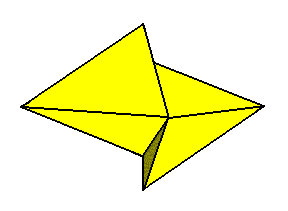
Of course the images of the Figures 12 and 14 also allow for f o u r antimers to be distinguished. However we stipulate them to have t w o antimers when we promorphologically describe an organism that tectologically consists of two antimers, and that is such that its basic form must be described by means of an amphitect gyroid pyramid that is derivable from a rhombic pyramid. A similar case we encountered in the case of the Diphragma (Heterostaura autopola).
With the Heteropola gyrostaura we have come to an end of the systematic treatment of the S t a u r a x o n i a, the Second Suborder of the Protaxonia ( The First Suborder is constituted by the M o n a x o n i a ).
The Third and last Suborder of the Protaxonia comprises all the s p i r a l f o r m s that occur in organisms. This Third Suborder is as such not recognized by Haeckel, because he considered all organic spiral forms (including shells) as belonging to the Dysdipleura. We on the other hand consider these spiral forms as a promorphological suborder in its own right. In them t h e m a i n a x i s o f t h e b o d y i s n o t s t r a i g h t b u t c o n s t a n t l y s p i r a l l y c u r v e d. We will call this Suborder accordingly "S p i r a x o n i a".
To continue click HERE to proceed further with the systematic Promorphology (Spiraxonia).
e-mail :

back to retrospect and continuation page
back to Internal Structure of 3-D Crystals
back to The Shapes of 3-D Crystals
back to The Thermodynamics of Crystals
back to Introduction to Promorphology
back to Anaxonia, Homaxonia, Polyaxonia
back to Protaxonia : Monaxonia
back to Stauraxonia heteropola
back to Homostaura anisopola, Heterostaura
back to Autopola oxystaura and orthostaura
back to Allopola (introduction)
back to Allopola amphipleura and zygopleura